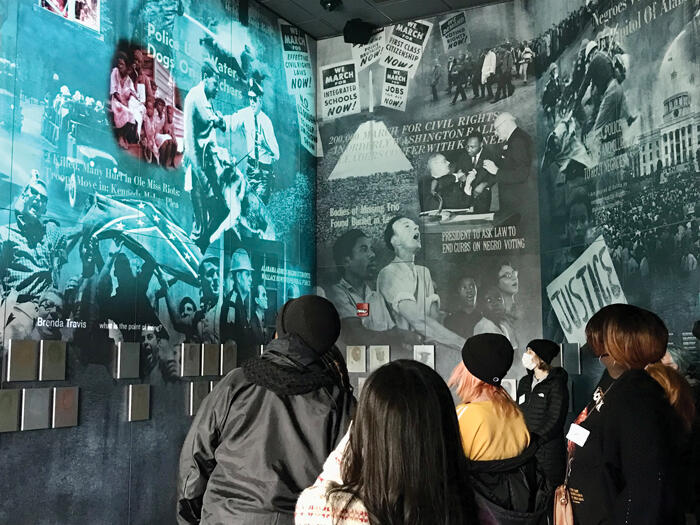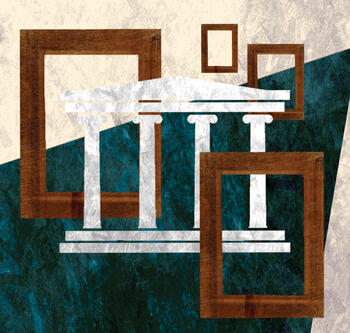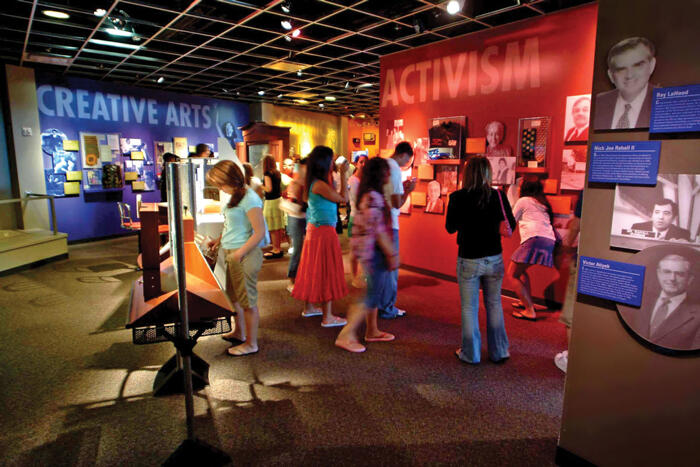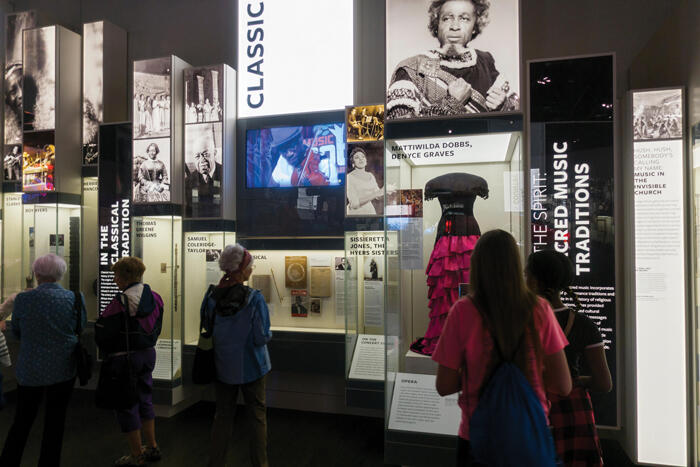For educators teaching the truth about race and racism in the United States, these are precarious times. As educators, students, caregivers and community members, we are all encountering a reality in which calculating legislators, special interest groups and some misinformed individuals want to eradicate racial justice education. As of December 15, 2021, according to an Education Week analysis, 29 states introduced bills to restrict teaching critical race theory or limit discussions of race, and 13 states successfully adopted the bans through legislation or other means. For many educators across the country, it is no longer safe to teach the truth.
“Now that schools are adopting [critical race theory bans] into administrative codes, school boards are passing resolutions, there’s this punitive umbrella that comes with it,” says Tafeni English, director of the Civil Rights Memorial Center (CRMC) at the Southern Poverty Law Center. English works closely with educators and school groups who visit the CRMC daily. “Educators—even the most courageous ones—will have that pause of, ‘OK, wait, is this going against some type of resolution or administrative code?’ ‘Could [there] possibly be a backlash?’ ‘What is the safest way?’”
These restrictions trigger justifiable fears of retaliation for so many teachers. For others, these limitations compound the strain of pre-existing ones, like district expectations or insufficient time in a school day.
“There are realities like testing and curricula and standards that lead you down certain paths,” says Jasmine Page, former classroom educator and now the education and interpretation manager at the National Center for Civil and Human Rights in Atlanta. “Educators do such amazing work, but they do it in such a constraint of time. Whether that be one day or the school year, it’s hard to tackle everything at once.”
Museum staff have a message for classroom educators: You do not have to face this struggle alone. Many museum sites make intentional space for school communities to learn about racial, gender and other histories and engage openly about it. Museum educators grow and learn from this public collaboration in equal measure.
“Museum educators have such an important role to play in the community,” Page says, “and schools are such pillars of the community. So the partnership is so important.”

Diversifying the Narrative
When museum and classroom educators work in tandem, students undertake a sophisticated investigation into both the breadth and depth of U.S. history. Classroom educators provide the historical context, secondary sources and some primary texts needed to understand the material. Supported by this wide-ranging backdrop, museum educators can narrow in on individual figures’ personal narratives, specific oral histories and artistic creations. This fusion allows the fullest range of historical facts possible. Classroom educators set the stage, and museums use artifacts to bring history to life.
“If the narratives don’t truly come alive,” says English, “we run the risk of not teaching true history. ... We move back to telling those stories through the eyes of the oppressor.”
When educators put their heads together, they can use their collective brainpower to include a greater diversity of narratives in history curricula. When they work in isolation, however, more stories may be overlooked.

Dave Serio, curator of education at the Arab American National Museum (AANM), says he barely heard anything about the Arab world as a student. “The only time I learned about it was possibly in history class,” he remembers. “It was usually ‘us versus them.’ It was usually in some type of political component where the U.S. was the good guy and the Arab countries were the bad guy.”
Most school districts don’t teach Arab American studies, Serio says, leaving the Arab American story “very much out of most curricula.”
The AANM uses artifacts to promote open dialogue about the difficult truths of the Arab American community’s history in the U.S. In 2017, Serio and his team coordinated an exhibit called “THEM,” exploring artifacts and images from the early 20th century onward that “reflect and encourage separation, hate and violence and foster prejudice and discrimination,” according to the exhibit’s description. The Jim Crow Museum of Racist Memorabilia contributed part of their collections, and Serio and his team added Arab American components. Museum educators used objects in the installation as a springboard for community dialogue.
Staff host conversations in the museum’s library, a comfortable, relaxed atmosphere outside of the classroom. Interacting with the historical artifacts helped students add personal reflection to critical inquiry, as students openly shared stories of times they had felt bullied, targeted or treated as “other.” The AANM also presents historical documents, oral histories and artifacts to preserve the contributions of Arab Americans and celebrate the community’s rich cultural history.
While many educators seek to be inclusive, it can be difficult to tackle everything. By partnering with experts at a museum, educators can collaborate to tell the truth about who is missing from the history books and why. And for students with shared identities and experiences, witnessing primary sources at sites like these can provide a lifeline in a sea of archival erasure and omission.
No educator can accurately map out the whole landscape of our history alone. We are all stronger when we traverse the terrain together.
“There are many examples of beautiful moments and special parts of every culture, things that inspire and empower us today,” says Ariel Moon, lead education specialist for Early Childhood Programs at the National Museum of African American History and Culture (NMAAHC). “There are some things for every racial identity to learn about and feel like, ‘This makes me feel affirmed to be me.’ And if you cut that out, every child will be starting from scratch in their journey towards thinking, ‘I’m worth something. I matter. I can make a difference.’”
When these inclusive cultural examples are overlooked, students may learn that their cultural histories are either invisible or do not matter enough to be shared.
Engaging Honestly About Race and Racism
In school classroom and museum spaces, skilled educators seek out open conversations about race and racism across lines of difference. Rather than going it alone, they consider this work the collective responsibility of a shared community. These educators forge partnerships to continually learn from and grow with others. They make productive dialogue a reality that expands beyond the walls of either institution.
While museum educators often spend just a few hours with students in informal, open-ended settings, classroom educators take months to create tight-knit communities in more formalized environments. Joining this carefully nurtured learning community, museum educators can directly delve into candid conversations about race in their limited time with students. When cultivated over time, this cooperative framework can become a public model for how a whole community can engage in racial truth-telling.
For some educators, constructing this community model is a personal first. Many–particularly white–educators did not practice talking about race and racial history as young people. While educators of color may be very familiar with talking about race, for some, discussing it across lines of difference feels less familiar. This lack of familiarity can breed dangerous consequences for everyone. Adults may default to shying away from the topic altogether at the expense of their students’ learning.
“A lot of times teachers, educators, caregivers and families, they are not coming out of a space in which they were taught how to talk about these things, or they were not acclimated to how to speak and confront the things they were seeing,” says Candra Flanagan, director of the Teaching and Learning Unit of NMAAHC’s education department. “A lot of adults don’t have the muscle built up to talk about it. So [now] they’re in their classroom and it’s not the easiest thing for them to do, or it’s not necessarily something that even comes to their mind.”
Museum educators may encounter the same mental barriers.
Lorraine McGarry and Virginia Squier were teaching high school and middle school, respectively, in State College, Pennsylvania, when students in their classes asked to learn more about the complexities of social justice. To respond, they collaborated on a combined elective called “Bridging Divides: Exploring Diversity and Social Justice.” Students spent the first part of the co-taught class investigating issues of division, discrimination and inequality through deliberative conversations and civic action.
As white educators, McGarry and Squier felt nagged by persistent discomfort with leading the class. To de-center their whiteness and practice cultural humility, they teamed up with seasoned educators at civil rights historic sites in the Deep South. They guided their students in a forum about racial justice with students from Birmingham in the basement of 16th Street Baptist Church. Museum educators with content expertise and lived experience taught students and teachers alike about the history of racial injustice and the civil rights movement. Their initial immersion in classroom learning inspired students to start conversations with tour guides and community members. This respectful, personal engagement benefited all involved.
At the museums, students listened as African American museum educators who had lived through the history told their own stories. In turn, Squier and McGarry saw their Black students resonate with their guides. “Students—especially students who felt like they didn’t have teachers in State College who had experienced what they’d experienced in terms of racial justice—felt this affirmation,” McGarry remembers. “There was this feeling of, ‘Someone gets what I’m going through.’”

Finding a Museum Ally
While museums and historic sites offer profound collaborative possibilities, it’s important to know which partnerships to prioritize. Not all museums have openly embraced an honest retelling of our nation’s history. Many, however, are undergoing a sea change. For example, in 2018, Thomas Jefferson’s historic home, Monticello, added exhibits about the 400 individuals Jefferson enslaved there, including one on Sally Hemings, the woman he kept in bondage who bore at least six of his children. James Madison’s plantation house, Montpelier, now highlights oral histories, artifacts and letters from the descendants of those he enslaved and features a film about the enduring legacy of slavery in the United States. It’s crucial to partner with a space that is willing to present all the facts.
Since its opening in 2016, the National Museum for African American History and Culture has committed to telling what historian John Hope Franklin called “the unvarnished truth.” Anna Hindley, director of NMAAHC’s Early Childhood Education Initiative, says the explicit value placed on reckoning with racial history has been “baked into the museum’s DNA” since its inception.
When searching for a museum educator partner, it may be beneficial to visit the museum anonymously first. A preliminary tour can offer information about the institution and provide a feel for its professional community. In the article “Preserving a More Honest History,” former Learning for Justice Senior Writer Cory Collins recommends looking for tour guides and staff who are both knowledgeable and open-minded. “A good staff will be responsive and adapt tours and educational experiences based on the needs of the educator and their students,” he writes.
Look for a willingness on the part of the institution and its staff members to honestly address racism and the truth of the past. A museum’s exhibits should feature inclusive content that leaves no significant stories—no matter how painful—untold. Prudent museum partners will honor accurate racial histories by humanizing the experiences of oppressed peoples. They may interweave their personal narratives, oral histories and artifacts into exhibits. Seek out a willingness from museum staff to embrace discomfort, Collins advises, and a clear connection between the past and the present.

Solidarity Equals Strength
Collaboration between schools and museums is key to advancing truthful education within both spheres. Allied educators understand the advantages of communicating openly about race and racism—and doing it together. They grasp how our collective future depends on it. When we don’t attend to race or racism in our past, says Hindley, students are “left to put together their own cognitive puzzle in this dissonance between what we [as educators] say and what this culture actually lives.”
Educators in classroom and museum sites alike share the responsibility of teaching students how to think for themselves by engaging with accurate sources and narratives. Shying away from the truth about our past, Hindley says, dishonors children as learners who naturally notice and observe the world around them. Equipping students with comprehensive knowledge and evidence of what has happened in the past supports them in countering injustice in the future.
No educator can accurately map out the whole landscape of our history alone. We are all stronger when we traverse the terrain together.
“We’re all constantly doing the work,” NMAAHC’s Flanagan says. “We don’t see ourselves as experts coming to the educators to bring them along to our level. We are alongside them, and we want to say, ‘Let’s link arms and do the work.’”

